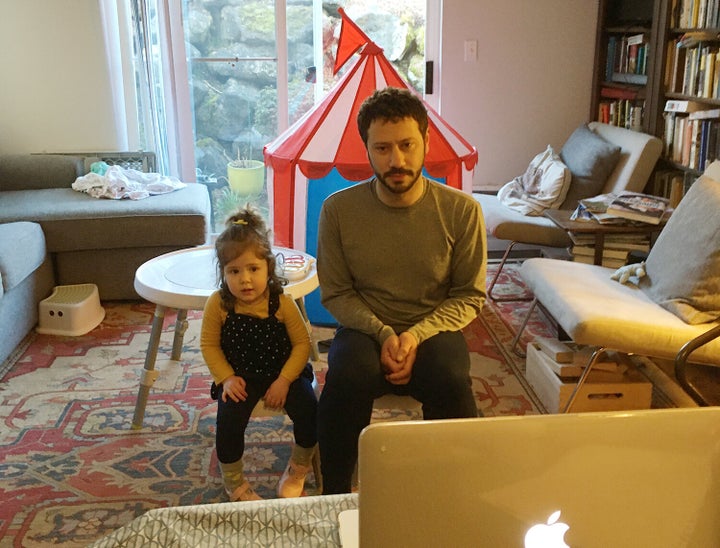SEATTLE ― Michelle was home when her phone buzzed with an automated text message from the school district: All K-12 schools will be closed for the next six weeks.
Michelle, a program manager working the heart of the nation’s novel coronavirus outbreak, had seen it coming. She had already started working from home to distance herself from her colleagues and was anticipating a notice soon since there were more reports of coronavirus cropping up around Seattle. (Michelle asked to be identified by only her first name, for fear of retribution from her employer.)
The school closures meant that her first-grader would be at home full time with her, her husband and her 4-year-old son. For the first time, she and her husband — and many other families — would have to take over many of the day-to-day responsibilities that were once outsourced to educators and child care providers.
Over the last two weeks in Seattle, institutions that had once given residents a sense of normalcy have shut down. Workplaces have encouraged employees to work from home as much as possible, if not made it compulsory. As it stands, schools will be closed through April 24. (California recently announced that its schools will be closed through the rest of the school year.)
Social gatherings of more than 50 people have been canceled, including the annual Womxn’s March. Last Sunday evening, Gov. Jay Inslee ordered a temporary closure of bars, restaurants and all places of entertainment.
“We’ve never had an event like this,” Sarah Jane Glynn says of the coronavirus pandemic and its effects. The senior fellow at the Center for American Progress who focuses on economic policies that impact working families adds: “Lots of parents are now expected to work remotely and at the same time, they’re home-schooling their children or providing child care during the day. That’s an impossible thing to expect people to do.”
Michelle, and everyone else in Seattle, is already a week into what is about to become the national reality amid closures and social distancing.
Working From Home, With Tiny Colleagues
Every night, after the kids are in bed, Michelle and her husband, an attorney, get their phones and laptops and talk about the next day. With their 6-year-old now at home, they take turns keeping him entertained and trying to not let him turn into “a YouTube zombie.”
Sharing schedules between her and her husband was “not a thing we’ve ever worried about,” Michelle said ― until now. What times can they alternate child care? And if both of them have a meeting at the same time, how can they keep their son occupied?
Many private day cares around the city are still open, and Michelle has still been sending her 4-year-old to one to get a bit of reprieve at home. The day cares that remain open have implemented measures to reduce the number of germs that could be transmitted, including by having kids spend more time outside, reducing the number of kids at the center, removing toys and other potentially germ-ridden surfaces, and ensuring only one parent is in the facility at a time. Even if parents pull their kids from day care, most centers still have families pay for tuition, to hold their spot for when things go back to normal.
Michelle at first wondered if continuing to go to day care was the right choice. “We’ve had a few hard conversations as parents,” says Michelle. “Should we pull him before recommendations say so? We’re not there at this point.” While access to day care has provided some relief, Michelle is also “waiting for the other shoe to drop” — for the guidelines on closures to extend to child care centers.

Not all working parents, however, want their children still going to day care for fear of community spread of the virus. Kate Brumage, a founder of a social enterprise nonprofit living in Seattle, pulled Helen, her 2-year-old, out of a private Spanish day care on March 11, after the day care center asked for those who worked at home to consider not bringing in their children.
At home, Brumage and her husband negotiate space and meetings in the confines of their 750-square-foot apartment ― with a portion of their living room set up with a tent so her daughter can video chat with her friends.
“It’s not that fun right now,” she says.
There is only one desk at home: hers, since she usually works from home. Brumage and her husband switch in and out of the office, depending on who has to hop on a call.
She used to work from cafes, but with the restaurant closures, there’s nowhere to go. “It’s claustrophobic,” Brumage says. And keeping her daughter entertained during normal working hours means that she is frequently still pulling a few extra hours of work after her daughter goes to bed at 7 p.m.
Brumage needs the work to support her family, and she feels a moral obligation to her clients.
“If I stopped doing my job, there would be financial consequences because I wouldn’t be able to fund the budget of the operation that pays me,” she says.
The Worker’s Reality
This ultimately ties into views of capitalism, says Glynn, which in essence make you feel like you need to be monetarily productive in order to be valuable.
Ordinarily, Brumage would have her 75-year-old mom come over ― she lives just three blocks away ― but given the recommendation that older people stay away from children or any other possible carriers of coronavirus, Brumage can’t call on her to help.
On the other hand, Christin Camacho, a content marketer in Seattle, has considered flying in her 65-year-old mother-in-law to help take care of her toddler and 6-month-old since getting a nanny might not be financially viable for her. “The economy needs to continue, and people need to make money. What are you going to do? Those are your options,” Camacho says.
Some families have hired nannies to come to their homes to watch their children while they work; others are deterred not only by the cost but the possible risk of getting the coronavirus by bringing others into their home. Ann Marie Ogle, a nanny in Seattle, told HuffPost that her phone was “ringing like a drug dealer’s” last week, when families were suddenly confronted with having to work from home and take care of their children. In her 20-plus years of being a nanny, Ogle has never been so busy.
Currently, the Trump administration is assembling a stimulus package valued at $1 trillion. Of that, $500 billion is projected to go toward U.S. tax-paying families.
The Families First Coronavirus Response Act, which was already signed by Trump, allows workers to get paid medical leave or family leave with help from the government. Unfortunately, it excludes workers if their company employs more than 500 or less than 50 people — the latter of which can apply for a waiver if they need leave to care for their children. “That still excludes 50% to 75% of the private sector workforce,” Glynn says.
Glynn says the legislation is a good first step in making sure American citizens have cash on hand as we’re heading into a global recession, largely caused by the coronavirus pandemic. “What we really need is paid leave for everyone,” she says.
Michelle acknowledges how privileged she and her family are to have employers who understand the challenges of balancing work with life. But she’s not sure how much longer this will go on, or how sustainable it will be to try to keep her son engaged in learning ― with scant instructions from the school ― while she and her husband are both expected to be productive at their jobs.
“I think that’s on everyone’s mind: Is this sustainable? Is this a pattern that we can maintain? I don’t know if we can honestly answer that without actually being in that situation,” she says.
- Read our live blog for the latest updates from HuffPost reporters around the world
- Living in a lockdown? Our reporters in Europe have advice on how to cope.
- Why you should act like you already have coronavirus, even if you don’t have symptoms
- How to grocery shop for a quarantine
- Doctors answer the most common coronavirus questions
- What to do if your friends or family aren’t taking coronavirus seriously
- Please don’t believe these coronavirus scams
- The HuffPost guide to working from home
- 10 ways to practice solidarity while social distancing
- What coronavirus questions are on your mind right now? We want to help you find answers.

